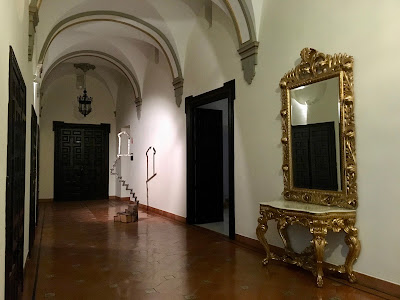The Bishop's Palace features a baroque red and yellow exterior and is on the north side of Plaza de Obispo. Built in the 16th to 18th centuries it is a series of buildings that take up the entire block.
 |
| Inner Courtyard just off entrance |
Walking to the far side of the courtyard there is another adjoining a connecting building and visible only via a glass wall.
Spinning around 180 degrees the view takes us back to the pink courtyard, entrance and past the wrought iron gates into the Plaza del Obispo.
The rooms on the ground floor of the Bishop's Palace feature religious art, mainly wooden sculptures of a caliber I've never had the opportunity before to view so closely.
This next sculpture is between three and four feet tall, but the detail and texture of her garments captured my attention and warranted a closer look.
Another lovely feature of the exhibit was the piped in audio recordings of hymns that added to the experience.
This next carved and painted wooden sculpture of Jesus is the most lifelike I've ever seen. Every detail from the soft flesh tones to his serene, sombre expression, trails of blood dripping down his torso to the rope binding his wrists are simply exquisite.
Just off this room is another courtyard. This one faces west and on the other side of the yellow building is Calle Fresca and our Airbnb flat.
Just beyond the fountain and carved stone fence is yet another courtyard. It is separated from the Bishop's Palace and inaccessible to visitors, but still part of the series of buildings that make up the palace.
Turning back to view the fountain there are three of the four tiled walls that feature images of daily life.
On the south facing wall is a window that opens up onto the Plaza del Obispo and tavernas.
Moving up to the second floor is done via an impressive imperial staircase. that includes an elliptical dome with an anonymous 18th century painting entitled the Trump of the Eucharist.
While I was walking up the stairs I heard and spotted this street musician via the window.
On the west side of the second floor is a chapel.
 |
| Alter |
The light filtering through the stained glass window made the madonna's crown shimmer.
Also included on the second floor was a contemporary exhibit by artist Juan Garaizabal. His many works are made of wood, steel and bricks from an untrained eye appear to have some religious meaning.
* * *
































